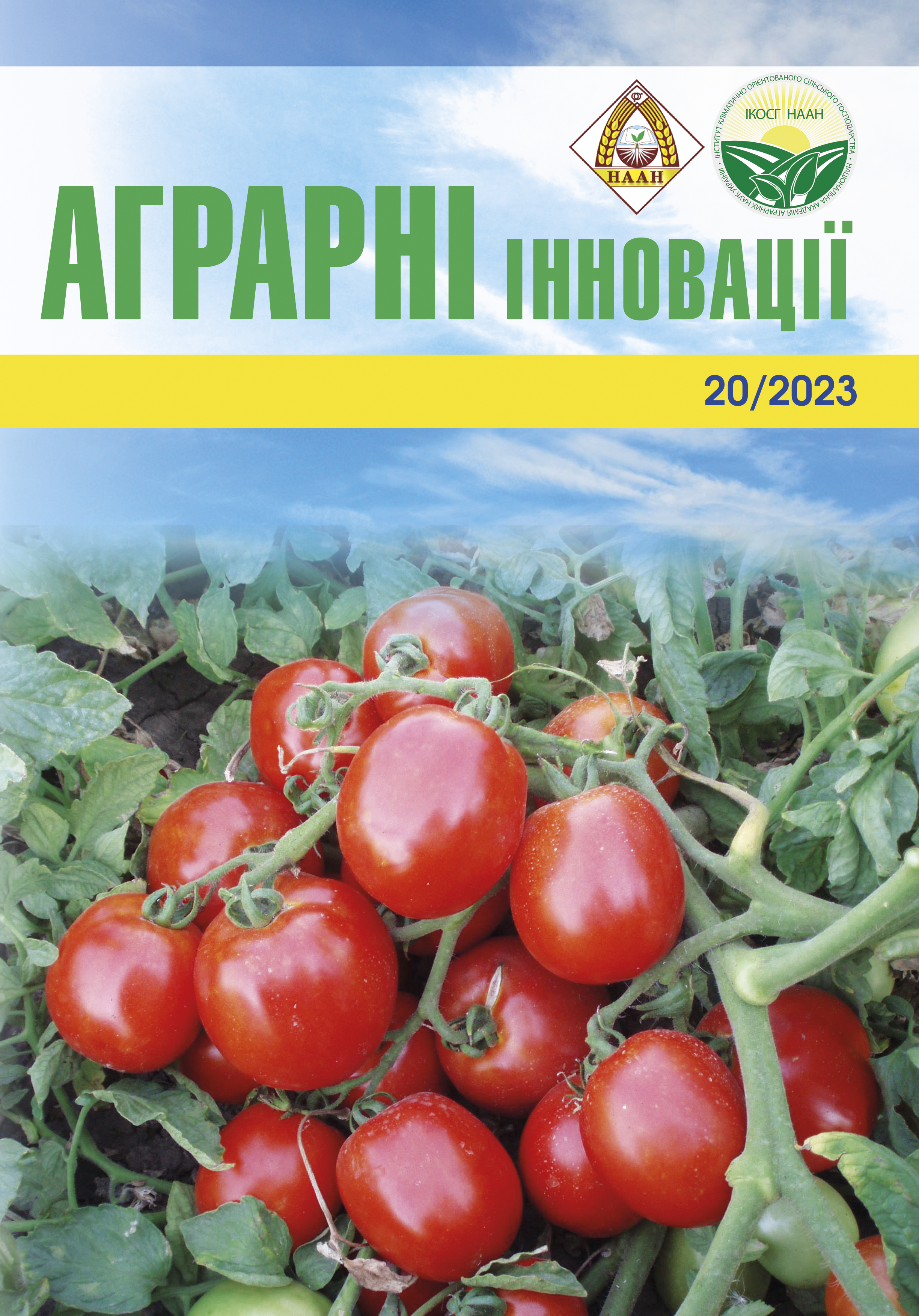System of presowing processing of guntu for watermelon
Abstract
Goal. To determine the influence of different tillagesystems on the physical properties and nutrient regimeof the soil; to investigate the peculiarities of the formationof moisture reserves in the soil depending on the timingof the main soil cultivation; to reveal the influence oftillage systems on the formation of the watermelonfruit crop. To develop the most effective system ofpre-sowing soil cultivation for watermelon for nonirrigatedconditions of the southern Steppe of Ukraine.Methods. The researches were based on complexuse of field, calculated-comparative mathematicalstatistical,methods and system analysis. Results. It wasestablished that the period of the main tillage affected thecontent and distribution of nutrients along the horizons ofthe arable layer of the soil. On average, over the yearsof research, the largest amount of nitrogen nitrates andmobile forms of phosphates in the plowed soil layerbefore sowing watermelon was contained after plowingthe soil. The analysis of the structural state of the soilshowed that the content of agronomically valuableaggregates (0.25–7.0 mm) in the plowed layer wasalmost independent of the methods of tillage of the soil forwatermelon at the appropriate plowing times. However,at later plowing times, an increase in the number ofthese aggregates by 2–3% was noted, compared to thecontrol. The most influential factor of the experiment overthe years of research was the timing of the main tillage.The highest fruit yield, both in individual years and onaverage over the years of the research, was obtainedon variants with fennel main tillage. Where the averageyield of watermelon was 20.4–23.4 t/ha, which is 2.1–5.1 t/ha more than when plowing in the “winter windows” and 2.9–5.9 t/ha, than during spring plowing. Reducingthe number of technological operations in the complex ofworks on pre-sowing soil cultivation, in options 3 and 4,made it possible to reduce the direct costs of productionby 75 and 125 hryvnias/ha, respectively, compared to thecontrol. However, such a decrease led to a lower yieldthan in the control, which in turn affected the indicators ofeconomic efficiency. Thus, the net profit in option 3 wasUAH 3,600/ha less, and the cost of fruits was UAH46.3/t higher than in the control. Conclusions. It hasbeen established that in the southern part of Ukraine,on chernozem soils with low humus content and nonirrigatedconditions, to ensure consistently high yields ofwatermelon fruits and create conditions for soil fertilitypreservation, moisture accumulation, and rational usage,it is necessary to implement a pre-sowing soil cultivationsystem. This system combines plowing to a depth of25–27 cm and autumn cultivation to a depth of 10–12 cm.The spring sequence of operations for pre-sowing soilcultivation for watermelon involves double-row plowingusing heavy harrows and pre-sowing cultivation to a depththat covers the seed while simultaneously harrowing.
References
2. Медведєв В. В., Булигін С. Ю., Вітвіцький С. В. Фізика ґрунту. Навчальний посібник. К.: Видавництво, 2018. 289 с.
3. Аверченко В.І. Ґрунтознавство: Навчальний посібник. Харків : Мачулін, 2018. 118 с.
4. Цилюрик О.І. Глибокий обробіток ґрунту: плюси та мінуси. Агробізнес сьогодні. 2018. URL: https://agrobusiness.com.ua/ahrarni-kultury/item/10599-hlybokyiobrobitok-gruntu-pliusy-ta-minusy.html (дата звернення 10.08.2023).
5. Демчук Н.О. Щоб було солодко. Все про вирощування кавунів та динь. SuperAgronom.com. 2020. URL: https://superagronom.com/articles/370-schobbulo-solodko-vse-pro-viroschuvannya-kavuniv-ta-din (дата звернення 10.08.2023).
6. Книш В.І. Обробіток грунту під кавун на неполивних землях Півдня України. Зрошуване землеробство: міжвідомчий тематичний науковий збірник. 2014. Вип. 61. Херсон : Грінь Д.С. С. 97–101.
7. Лихацький В.І. Баштанництво. Навчальний посібник. К.: Вища школа, 2002. 166 с.
8. Писаренко В.М., Писаренко П.В., Писаренко В.В., Горб О.О., Чайка Т.О. Посухи в контексті змін клімату України. Вісник Полтавської Державної аграрної академії. 2019. Вип. 1. С. 134–149.
9. Методика дослідної справи в овочівництві і баштанництві / за ред. Г.Л. Бондаренка, К.І. Яковенка. Харків : Основа, 2001. 369 с.
10. Лимар А.О., Сніговий В.С. Методика селекційного процесу та проведення польових дослідів з баштанними культурами: Методичні рекомендації. Київ: Аграрна наука, 2001. 132 с.
11. Лимар А.О. Баштанництво України : Монографія. Миколаїв : Миколаївський державний аграрний університет, 2007. 232 с.
12. Польовий А.М., Гуцал А.І., Дронова О.О. Грунтознавство: навч. посібник Одеса : «Екологія», 2013. 668 с.
13. Канівець В.І., Канівець С.В., Матухно Ю.Д., Кулик Н.А. Особливості чорноземів, які залягають уздовж південносхідної межі розповсюдження чорноземів вилужених на Лівобережжі України. Агрохімія і ґрунтознавство. 2014. Вип. 81. С. 40–44.






